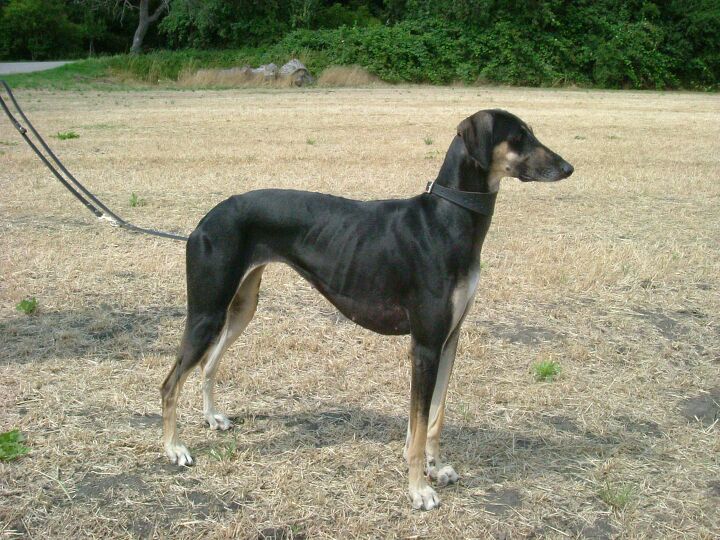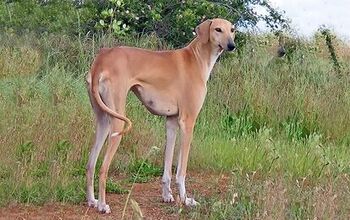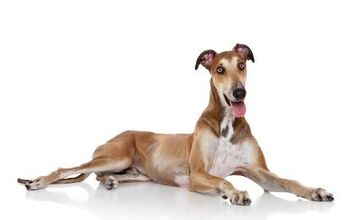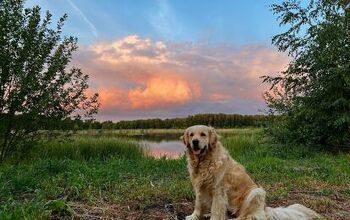Sloughi


About Sloughi
With its sleek good looks, the Sloughi makes for a handsome and energetic family companion. Because this noble breed is considered a sighthound, this dog is happiest when he has a large, fenced backyard in which to run and chase toys. Many people confuse the Sloughi for a Saluki. Although both breeds have similar ancestors, the Sloughi is a one-of-a-kind dog.
The Sloughi is gentle with his family but is rather reserved around strangers. People often confuse his aloofness with shyness. This dog should never be shy and should always be well-socialized. This wonderful hound will win you over with his sweet disposition, easy to care for coat and athleticism.
With its sleek good looks, the Sloughi makes for a handsome and energetic family companion.
Originating in Northern Africa, the Sloughi was bred by the Berbers in Tunisia, Libya, Algeria and Morocco. No one knows when the breed came into existence however; it is believed to have been around since at least the 13th Century. This breed was favored because of his intense desire to chase as well as his unshakable hunting abilities. Game such as wild boar, gazelle, jackals and fox are no match for the hunting prowess of this dog.
The true pedigree of the Sloughi is completely unknown however; many Sloughi enthusiasts believe that this breed is closely related to the Afghan Hound, Saluki and Azawakh. Many speculate that the breed was named so because of its speed. The Arabic word for “fast as the wind” is Sloughi.
Because the Sloughi has a strong need for speed, it is essential that you provide him with a diet of dry kibble specifically formulated for his high energy level. It’s wise to feed two meals as opposed to one meal daily to prevent bloat. Of course, always have fresh, clean water available for the dog.
When it comes to training a Sloughi, some lessons will be easier than others.
When it comes to training a Sloughi, some lessons will be easier than others. He can easily be trained to retrieve or lure course but parlor tricks such as play dead or roll over can prove to be much more difficult. He will be more apt to learn things that are related to what he loves to do, such as chasing down and returning a ball.
All training should be done with positive reinforcement. Repetitive lessons and rewards seem to work best for the Sloughi. Their feelings are easily hurt so yelling and reprimands should be avoided.
As in most breeds, the male Sloughi is larger than the female. The average male weighs between 55 and 65 pounds and stands between 26 and 29 inches tall at the withers. Females range between 45 and 50 pounds and are between 24 and 27 inches at the withers.
The best way to describe the temperament of a Sloughi is cat-like. He is aloof and reserved but never fearful or shy. Loyal and loving, this dog attaches to his family quickly and the bond never breaks. The Sloughi has been described as a one-man dog however; he will easily bond with the entire family. It’s important that this breed be kept indoors with the family. He is social with his humans and needs the love and affection of his family.
One of the best characteristics of the Sloughi is that they are quiet dogs. They are in no way, shape or form barkers. They will alert their owners of the presence of a stranger however; they are not overbearing barkers. This makes this breed the perfect companion for active families.
An exceptionally healthy breed of dog, the Sloughi does not carry the health issue baggage that affects many large dogs. Very few genetic problems are associated with this breed. The breed can be predisposed to PRA or Progressive Retinal Atrophy. PRA can cause blindness so clear parents are important for breeding healthy puppies. Hypothyroidism and heart murmurs of all grades have been found in the breed. Severe reactions to vaccines, medications and anesthesia occur quite often in the Sloughi. Fortunately, they are generally healthy dogs so few people experience these problems.
Because of its minimal hereditary issues, the lifespan of the Sloughi is between 12 and 15 years of age.
Being a sighthound, the Sloughi is a very athletic dog. He requires lots of room to run in a securely fenced area. This is not the breed of dog for a sedentary family who prefer lounging on the couch to a nice run through the park. Treadmills are not a substitute for running outdoors, although many people allow their dogs to use them during inclement weather conditions.
A Sloughi is a great family companion and will enjoy playing with children in the yard. They can easily be trained to play fetch which will keep both the dog and the kids occupied for hours.
The best way to describe the temperament of a Sloughi is cat-like. He is aloof and reserved but never fearful or shy.
The American Kennel Club states: “An ancient breed, it is treasured in North Africa for its hunting skills, speed, agility, and endurance over long distances. The breed is noble and somewhat aloof, with a gentle, melancholy expression”. The Sloughi was first brought to the United States in 1973.
A shorthaired breed, the Sloughi’s coat should be smooth and rather fine. It does not have feathering or areas with longhair anywhere on its body or legs. This dog has a variety of acceptable coat colors that can range from cream to deep fawn however; darker colored and black ones have been known to occur.
Grooming is quite minimal. Frequent bathing is unnecessary as the consistency of the coat repels dirt and grime. The occasional brushing with a grooming glove or a soft bristled brush will keep your in tip-top shape.
Sloughi puppies need to be socialized from the very start. Because of their naturally reserved temperament, socialization with different people and situations can help to keep the dog from becoming wary of new people and things. Housebreaking and crate-training must be started immediately as it can prove to be difficult being housetrained.

Amy Tokic, Editor of PetGuide.com, is a passionate animal lover and proud pet parent of Oscar, a Shih Tzu/Chihuahua cross, and Zed, a Japanese Chin. Her love of animals began in kindergarten, when she brought her stuffed dog Snoopy into class with her every day. Now, she writes about her adventures in pet ownership and tirelessly researches products, news and health related issues she can share with other animal enthusiasts. In her free time, Amy loves perusing used book and record stores, obsessing over the latest pet products available and chasing squirrels with wild abandon (a habit attributed to spending too much time with her pooches).
More by Amy Tokic

























